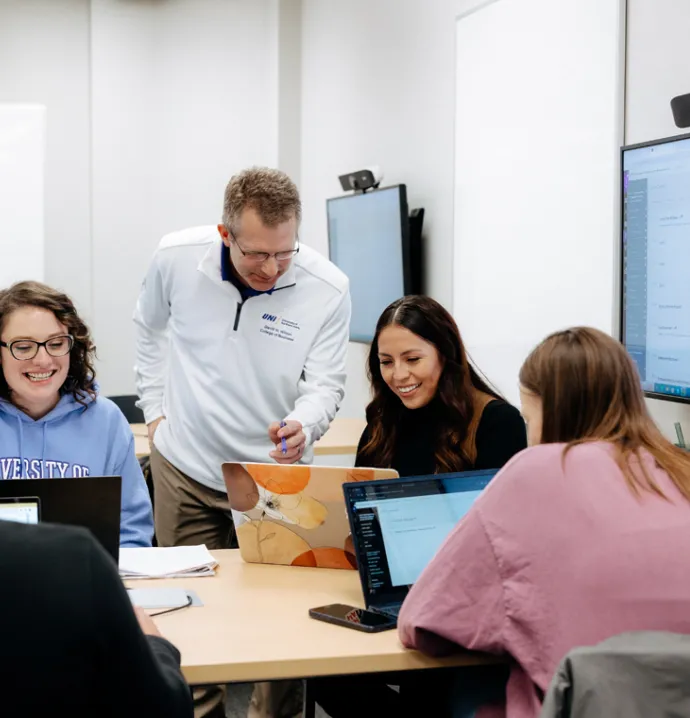IT quickly adapts to soaring demand as classes move online
IT quickly adapts to soaring demand as classes move online
It started as a pilot project to provide about 50 University of Northern Iowa students with remote access to specialized software.
But with the dawn of the coronavirus and the wave of campus closures and remote learning that followed, demand for the small pilot project surged to serve more than 1,000 students in just two weeks.
Welcome to the new normal for UNI’s IT Department.
As students and faculty moved to online learning and remote access to many IT services in early March, the department has been putting in long hours behind the scenes to ensure a smooth transition. The process presented unforeseen challenges, but the department rose to the occasion to respond to increases in service requests, faculty training, Wi-Fi coverage and other requests that have cropped up during this monumental shift.
“We’re working a lot more hours than normal,” said Ben Arnold, director of client services within the IT department. “As each challenge presented itself, we’ve quickly been able to develop a solution so people aren’t waiting on us long. It’s really brought in a focus for our team and, man, are they dedicated.”
The pilot program mentioned above was for remote access via Citrix to expensive software, such as the Adobe suite, that students need but are commonly found only in UNI computer labs. It began in late February.
“Our goal was to load test the system and work out any issues students encountered prior to making it available on a larger scale,” said Peter Callaghan, senior systems administrator.
But then the coronavirus hit and everything changed. The pressure was on.
The announcement that UNI was transitioning to online courses was sent out March 11. By March 23, more than 1,000 students had access to Citrix. In that time, faculty requests for software additions to the remote platform surged - between 40 and 50 in total, in addition to the 10 titles already offered.
Typically, the process to add just one new software application can take up to a week, Callaghan said. The department had all the requests processed in just nine days.
“It was an intense week,” said Nate Klosterman, director of network and infrastructure services. “Everybody was concentrating on how we can get people in remotely. It was fast and furious for a while.”
The IT Service Desk also had to undergo a rapid transition, as many of their services had typically required face-to-face interactions, such as classroom support, personal device repair for students and more.
They also made their own transition to working off-campus, working with the network and infrastructure services team to find the right software to answer service calls remotely.The service desk also worked with student employees to respond to issues in Service Hub and chat messages.
Processing Service Hub requests and client support was also bolstered by the efforts of other parts of the IT department, said Todd Thomas, IT service desk manager.
“Many IT areas have developed documentation to ease the transition to teaching, working and learning remotely, which in turn helped our department provide additional resources to frequently asked questions,” Thomas said. “It's been a big effort to change our support model, but thanks to quick responses and extra help from the IT staff involved, we are available to help.”
The support has been necessary. In March, the service desk saw an additional 1,000 requests submitted through Service Hub, a 33% increase from last year.
The use of Zoom and Google Hangouts has also skyrocketed. Early in the year, Zoom meetings would max out at about 75 per day. Since the transition to online courses, there have been 580 Zoom meetings per day, Klosterman said. Google Hangouts saw a similar uptick, moving from a max of 10 per day to 234 meetings per in the past week.
And while much of the IT department’s work occurs in virtual environments, there were still tasks to complete in the real world.
One request from senior leaders in UNI’s COVID-19 response team was to provide outside wireless for students to access on campus from their cars to maintain social distancing guidelines. The team had to physically build a wireless system to cover the parking lot west of Noehren and Hageman hall. The team completed the task in less than two days, Klosterman said.
Another issue that cropped up was students who still wanted to access the printing services normally housed in the now-closed Rod Library. Arnold’s client services team scrambled to move a set of printers to the UNI Bookstore. But, just 24 hours later, the bookstore closed, and the printers were quickly moved to Gilchrist Hall.
“Printers are difficult because they’re one of the things that break the most frequently, but we came together because students needed that,” Arnold said. “It’s really been, ‘what do we need to do to make this work?’”
The shift to online courses was sudden and swift, but for faculty with questions about effective online teaching strategies and troubleshooting, the Office on Continuing and Distance Education has provided ongoing, individualized support.
These issues, ranging from help assigning quizzes in Blackboard to broader questions on online teaching techniques, have been addressed with a mixture of training resources and documentation online.
The workload has stressed the limits of the office’s staff, but they have persevered through the unified goal of helping students succeed, said Kent Johnson, dean of continuing education and special programs.
"We've always had a robust set of technology tools,” Johnson said. “But the spirit of collaboration and commitment to help students succeed among faculty and staff -- along with the strong work ethic of UNI students -- has made the transition from face-to-face instruction to online as seamless as it could possibly be. "




